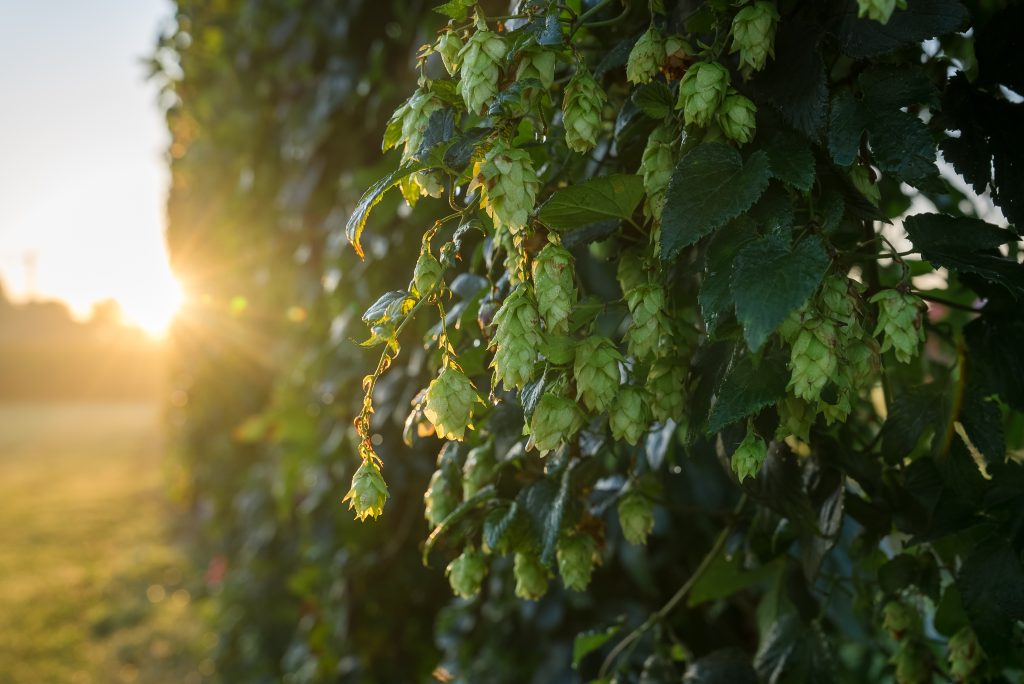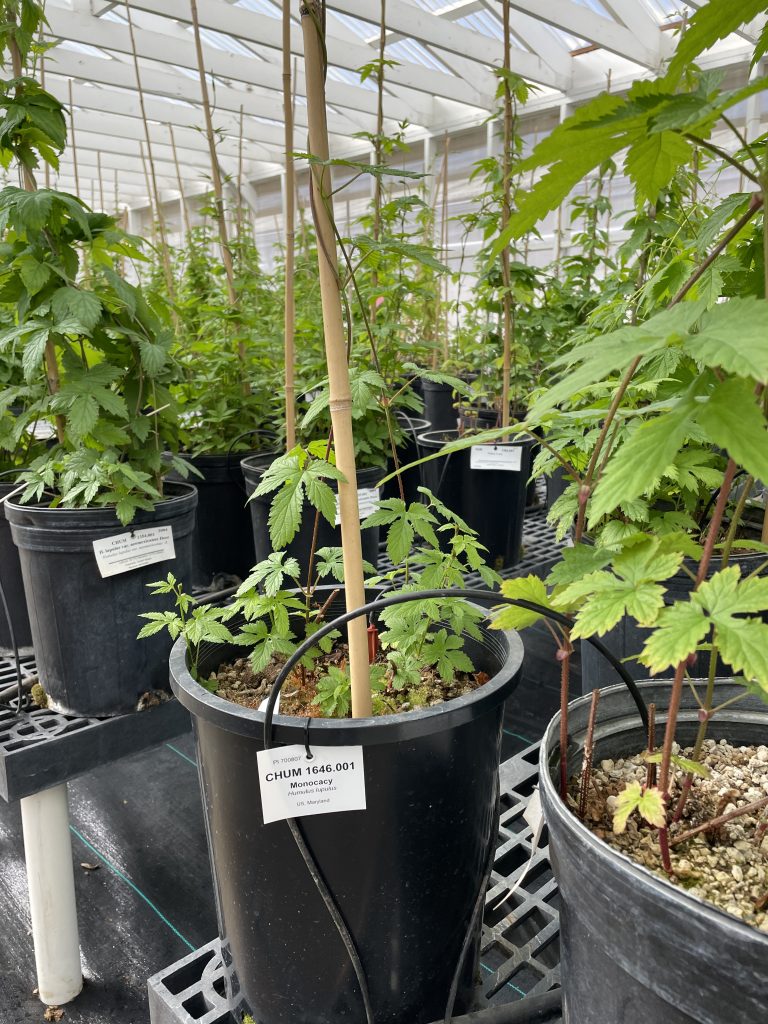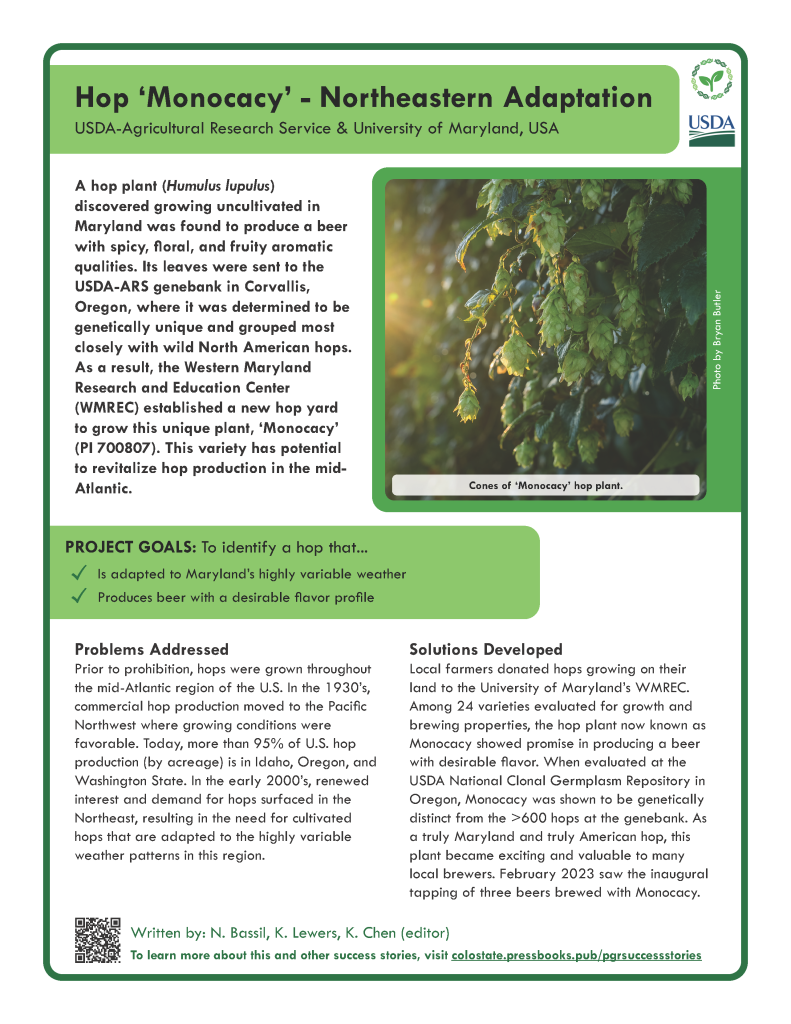Sugars, Starches, and Beverages
Hop ‘Monocacy’ – Northeastern Adaptation
‘MONOCACY’: A UNIQUE MARYLAND HOP PLANT INITIATING THE BREWING OF THREE LOCAL BEERS
Nahla Bassil and Kim Lewers
USDA-ARS National Clonal Germplasm Repository, 33447 Peoria Rd, Corvallis, Oregon 97333.
USDA-ARS Genetic Improvement of Fruits and Vegetables Laboratory, Bldg. 010A, 10300 Baltimore Ave, Beltsville, Maryland 20705.
Corresponding author: nahla.bassil@usda.gov
OUTLINE
- Summary
- Problems addressed
- Solutions developed
- Impact
- Germplasm
- Additional resources
- Chapter information
1. SUMMARY

A small number of cones from a hop plant (Humulus lupulus) of unknown origin and history that was discovered in the late 1960’s in the yard of Green Spring Farm in Fredrick County, Maryland, resulted in a beer with spicy, floral, and fruity aromatic qualities. The USDA-ARS National Clonal Germplasm Repository genetics team in Corvallis, Oregon, determined it to be genetically unique and grouped most closely with wild North American hops. This plant received the accession number PI 700807 and was named ‘Monocacy’. A new hop yard was established in 2022 at the Western Maryland Research and Education Center with approximately 200 plants of ‘Monocacy’ and is being managed as a commercial hop yard.
The goal was to identify hop plants that are adapted to Maryland’s highly variable weather and could be used to brew delicious local beer.
Download a printable fact sheet by clicking the image below.
2. PROBLEMS ADDRESSED
Prior to prohibition, hops were grown throughout the mid-Atlantic region of the U.S. In the 1930’s, commercial hop production moved to the Pacific Northwest where the arid climate and abundant irrigation water presented favorable growing conditions. Today, more than 95% of U.S. hop production (by acreage) is in Idaho, Oregon, and Washington State. In the early 2000’s, renewed interest and demand for hops surfaced in the Northeast, resulting in the need for locally-adapted hops, suitable for the highly variable weather in this region.
3. SOLUTIONS DEVELOPED

Local farmers donated hop plants growing on their farms to the University of Maryland’s Western Maryland Research and Education Center for evaluation. Among 24 varieties/local plants evaluated for growth and beer brewing properties, one hop plant growing at Green Spring Farm showed promise in producing a beer with desirable flavor. Leaves from this plant were sent to the USDA-ARS National Clonal Germplasm Repository (NCGR) in Corvallis, Oregon to identify using DNA-based fingerprinting. The genetics team determined it to have a unique genotype when comparing its DNA to that of >600 hop plants; the hop plants included the majority of heirloom and commonly grown hop cultivars and some wild North American genotypes. This unique plant was named after the Monocacy River Watershed, the location where it was discovered and where it would be grown. ‘Monocacy’ was quickly made available for research and breeding, with increasing access for Maryland brewers.
Collaborators involved in developing solution:
- Mandie Driskill and Ryan King USDA-ARS NCGR, Corvallis, Oregon, USA
- Bryan Butler, University of Maryland Extension, Westminster, Maryland, USA
- Tom Barse, Milkhouse Brewery at Stillpoint Farm, Mount Airy, Maryland, USA
4. IMPACT

This hop plant became exciting and valuable to many local brewers only because NCGR provided the evidence needed to claim it as a truly Maryland hop, unique and most closely related to wild North American hop. Brewers, growers, and plant propagators gain a marketing advantage by claiming it as a true Maryland hop and a true American hop. The Hop Growers of America accepted an article on the discovery and evaluation of ‘Monocacy’ in their Hop News. On February 7, 2023, the Brewers Association of Maryland, Milkhouse Brewery, the University of Maryland Extension, and Grow & Fortify hosted the inaugural tapping of three beers made with ‘Monocacy’.
5. GERMPLASM
‘Monocacy’ (PI 700807) was a wild hop collected from a farm in Fredrick County, Maryland (latitude 39.3123N, longitude 77.2341W). It was donated, becoming a genebank accession in the USDA National Plant Germplasm System in 2022.
More information can be found at GRIN-Global: PI 700807.
6. ADDITIONAL RESOURCES
Driskill MJ, Pardee K, Hummer KE, Zurn J, Amundsen K, Wiles A, Wiedow C, Patzak J, Henning JA, Bassil NV. 2022. Two fingerprinting sets for Humulus lupulus based on KASP and microsatellite markers. PLoS ONE 17:e0257746. https://doi.org/10.1371/journal.pone.0257746
All About Beer (includes a podcast): https://allaboutbeer.com/introducing-the-monocacy-hop/
Baltimore Sun: https://www.baltimoresun.com/food-drink/bs-fo-maryland-native-monocacy-hops-20230218-ckj32fjz75hmtmcyvhizqnd7xu-story.html
Yahoo News (includes a podcast): https://news.yahoo.com/uncapped-monocacy-hop-001900698.html
7. CHAPTER INFORMATION
Citation: Bassil N, Lewers K. 2023. Hop ‘Monocacy’ – Northeastern Adaptation. In: Volk GM, Chen K, Byrne P (Eds.) Plant Genetic Resources: Success Stories. Fort Collins, Colorado: Colorado State University. Date accessed. Available from https://colostate.pressbooks.pub/pgrsuccessstories/chapter/hop-monocacy-northeastern-adaptation/
Content originally submitted: April 28, 2023
Date of publication: July 2023
USDA is an equal opportunity provider, employer, and lender. Mention of trade names or commercial products in this article is solely for the purpose of providing specific information and does not imply recommendation or endorsement by the U.S. Department of Agriculture.


